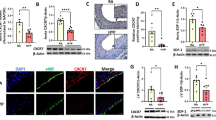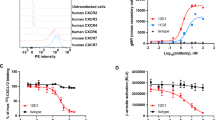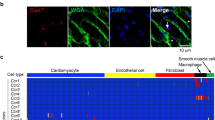Abstract
Introduction:
Chemokines may directly participate in the pathogenesis of neonatal chronic hypoxia–induced pulmonary hypertension (PH). Although stromal-derived factor-1 (SDF-1) has been shown to be involved in PH, the role of its most recently discovered receptor, chemokine receptor type 7 (CXCR7), remains unclear. We sought to determine whether antagonism of the CXCR7 receptor would decrease pulmonary vascular remodeling in newborn mice exposed to chronic hypoxia by decreasing pulmonary vascular cell proliferation.
Methods:
Neonatal mice were exposed to hypoxia (fractional inspired oxygen concentration = 0.12) or room air (RA) for 2 wk. After 1 wk of exposure, mice received daily injections of placebo or a CXCR7 antagonist (CCX771) from postnatal day 7 (P7) to P14. Right ventricular systolic pressure (RVSP), the ratio of the weight of the right ventricle to left ventricle + septum (RV/LV + S), and pulmonary vascular cell proliferation and remodeling were determined at P14.
Results:
As compared with mice exposed to RA, hypoxia placebo mice had a significant increase in the lung protein expression of CXCR7. Although hypoxic placebo-treated mice had a significant increase in RVSP, RV/LV+S, and pulmonary vascular cell proliferation and remodeling, the administration of CCX771 markedly decreased these changes.
Discussion:
These results indicate that antagonism of CXCR7 may be a potent strategy to decrease PH and vascular remodeling.
Similar content being viewed by others
Log in or create a free account to read this content
Gain free access to this article, as well as selected content from this journal and more on nature.com
or
References
Walsh-Sukys MC, Tyson JE, Wright LL, et al. Persistent pulmonary hypertension of the newborn in the era before nitric oxide: practice variation and outcomes. Pediatrics 2000;105(1 Pt 1):14–20.
Tuder RM, Voelkel NF . Pulmonary hypertension and inflammation. J Lab Clin Med 1998;132:16–24.
Dorfmüller P, Perros F, Balabanian K, Humbert M . Inflammation in pulmonary arterial hypertension. Eur Respir J 2003;22:358–63.
Rollins BJ . Chemokines. Blood 1997;90:909–28.
Balabanian K, Foussat A, Dorfmüller P, et al. CX(3)C chemokine fractalkine in pulmonary arterial hypertension. Am J Respir Crit Care Med 2002;165:1419–25.
Kucia M, Jankowski K, Reca R, et al. CXCR4-SDF-1 signalling, locomotion, chemotaxis and adhesion. J Mol Histol 2004;35:233–45.
Plotkin J, Prockop SE, Lepique A, Petrie HT . Critical role for CXCR4 signaling in progenitor localization and T cell differentiation in the postnatal thymus. J Immunol 2003;171:4521–7.
Balabanian K, Lagane B, Infantino S, et al. The chemokine SDF-1/CXCL12 binds to and signals through the orphan receptor RDC1 in T lymphocytes. J Biol Chem 2005;280:35760–6.
Burns JM, Summers BC, Wang Y, et al. A novel chemokine receptor for SDF-1 and I-TAC involved in cell survival, cell adhesion, and tumor development. J Exp Med 2006;203:2201–13.
Young KC, Torres E, Hatzistergos KE, Hehre D, Suguihara C, Hare JM . Inhibition of the SDF-1/CXCR4 axis attenuates neonatal hypoxia-induced pulmonary hypertension. Circ Res 2009;104:1293–301.
Burke DL, Frid MG, Kunrath CL, et al. Sustained hypoxia promotes the development of a pulmonary artery-specific chronic inflammatory microenvironment. Am J Physiol Lung Cell Mol Physiol 2009;297:L238–50.
Costello CM, McCullagh B, Howell K, et al. A role for the CXCL12 receptor, CXCR7, in the pathogenesis of human pulmonary vascular disease. Eur Respir J 2011; e-pub ahead of print 16 November 2011.
Gambaryan N, Perros F, Montani D, et al. Targeting of c-kit+ haematopoietic progenitor cells prevents hypoxic pulmonary hypertension. Eur Respir J 2011;37:1392–9.
Rajagopal S, Kim J, Ahn S, et al. Beta-Arrestin- but not G protein-mediated signaling by the “decoy” receptor CXCR7. Proc Natl Acad Sci USA 2010;107:628–32.
Meijer J, Ogink J, Roos E . Effect of the chemokine receptor CXCR7 on proliferation of carcinoma cells in vitro and in vivo. Br J Cancer 2008;99:1493–501.
Miao Z, Luker KE, Summers BC, et al. CXCR7 (RDC1) promotes breast and lung tumor growth in vivo and is expressed on tumor-associated vasculature. Proc Natl Acad Sci USA 2007;104:15735–40.
Wang J, Shiozawa Y, Wang J, et al. The role of CXCR7/RDC1 as a chemokine receptor for CXCL12/SDF-1 in prostate cancer. J Biol Chem 2008;283:4283–94.
Costello CM, Howell K, Cahill E, et al. Lung-selective gene responses to alveolar hypoxia: potential role for the bone morphogenetic antagonist gremlin in pulmonary hypertension. Am J Physiol Lung Cell Mol Physiol 2008;295:L272–84.
Vicencio AG, Eickelberg O, Stankewich MC, Kashgarian M, Haddad GG . Regulation of TGF-beta ligand and receptor expression in neonatal rat lungs exposed to chronic hypoxia. J Appl Physiol 2002;93:1123–30.
Cruz-Orengo L, Holman DW, Dorsey D, et al. CXCR7 influences leukocyte entry into the CNS parenchyma by controlling abluminal CXCL12 abundance during autoimmunity. J Exp Med 2011;208:327–39.
Hassoun PM, Mouthon L, Barberà JA, et al. Inflammation, growth factors, and pulmonary vascular remodeling. J Am Coll Cardiol 2009;54(1 Suppl):S10–9.
Minamino T, Christou H, Hsieh CM, et al. Targeted expression of heme oxygenase-1 prevents the pulmonary inflammatory and vascular responses to hypoxia. Proc Natl Acad Sci USA 2001;98:8798–803.
Fujita M, Shannon JM, Irvin CG, et al. Overexpression of tumor necrosis factor-alpha produces an increase in lung volumes and pulmonary hypertension. Am J Physiol Lung Cell Mol Physiol 2001;280:L39–49.
Ito T, Okada T, Miyashita H, et al. Interleukin-10 expression mediated by an adeno-associated virus vector prevents monocrotaline-induced pulmonary arterial hypertension in rats. Circ Res 2007;101:734–41.
Gerrits H, van Ingen Schenau DS, Bakker NE, et al. Early postnatal lethality and cardiovascular defects in CXCR7-deficient mice. Genesis 2008;46:235–45.
Berahovich RD, Zabel BA, Penfold ME, et al. CXCR7 protein is not expressed on human or mouse leukocytes. J Immunol 2010;185:5130–9.
Neusser MA, Kraus AK, Regele H, et al. The chemokine receptor CXCR7 is expressed on lymphatic endothelial cells during renal allograft rejection. Kidney Int 2010;77:801–8.
Boldajipour B, Mahabaleshwar H, Kardash E, et al. Control of chemokine-guided cell migration by ligand sequestration. Cell 2008;132:463–73.
Naumann U, Cameroni E, Pruenster M, et al. CXCR7 functions as a scavenger for CXCL12 and CXCL11. PLoS ONE 2010;5:e9175.
Odemis V, Boosmann K, Heinen A, Küry P, Engele J . CXCR7 is an active component of SDF-1 signalling in astrocytes and Schwann cells. J Cell Sci 2010;123(Pt 7):1081–8.
Mazzinghi B, Ronconi E, Lazzeri E, et al. Essential but differential role for CXCR4 and CXCR7 in the therapeutic homing of human renal progenitor cells. J Exp Med 2008;205:479–90.
Sánchez-Martín L, Estecha A, Samaniego R, Sánchez-Ramón S, Vega MÁ, Sánchez-Mateos P . The chemokine CXCL12 regulates monocyte-macrophage differentiation and RUNX3 expression. Blood 2011;117:88–97.
Décaillot FM, Kazmi MA, Lin Y, Ray-Saha S, Sakmar TP, Sachdev P . CXCR7/CXCR4 heterodimer constitutively recruits beta-arrestin to enhance cell migration. J Biol Chem 2011;286:32188–97.
Sierro F, Biben C, Martínez-Muñoz L, et al. Disrupted cardiac development but normal hematopoiesis in mice deficient in the second CXCL12/SDF-1 receptor, CXCR7. Proc Natl Acad Sci USA 2007;104:14759–64.
Möhle R, Bautz F, Rafii S, Moore MA, Brugger W, Kanz L . The chemokine receptor CXCR-4 is expressed on CD34+ hematopoietic progenitors and leukemic cells and mediates transendothelial migration induced by stromal cell-derived factor-1. Blood 1998;91:4523–30.
Stenmark KR, Fagan KA, Frid MG . Hypoxia-induced pulmonary vascular remodeling: cellular and molecular mechanisms. Circ Res 2006;99:675–91.
Yue TL, Wang X, Sung CP, et al. Interleukin-8. A mitogen and chemoattractant for vascular smooth muscle cells. Circ Res 1994;75:1–7.
Sanchez O, Marcos E, Perros F, et al. Role of endothelium-derived CC chemokine ligand 2 in idiopathic pulmonary arterial hypertension. Am J Respir Crit Care Med 2007;176:1041–7.
Perros F, Dorfmüller P, Souza R, et al. Fractalkine-induced smooth muscle cell proliferation in pulmonary hypertension. Eur Respir J 2007;29:937–43.
Sungprem K, Khongphatthanayothin A, Kiettisanpipop P, Chotivitayatarakorn P, Poovorawan Y, Lertsapcharoen P . Serum level of soluble intercellular adhesion molecule-1 correlates with pulmonary arterial pressure in children with congenital heart disease. Pediatr Cardiol 2009;30:472–6.
Satoh K, Fukumoto Y, Nakano M, et al. Statin ameliorates hypoxia-induced pulmonary hypertension associated with down-regulated stromal cell-derived factor-1. Cardiovasc Res 2009;81:226–34.
Zabel BA, Wang Y, Lewén S, et al. Elucidation of CXCR7-mediated signaling events and inhibition of CXCR4-mediated tumor cell transendothelial migration by CXCR7 ligands. J Immunol 2009;183:3204–11.
Author information
Authors and Affiliations
Corresponding author
Rights and permissions
About this article
Cite this article
Sartina, E., Suguihara, C., Ramchandran, S. et al. Antagonism of CXCR7 attenuates chronic hypoxia–induced pulmonary hypertension. Pediatr Res 71, 682–688 (2012). https://doi.org/10.1038/pr.2012.30
Received:
Accepted:
Published:
Issue date:
DOI: https://doi.org/10.1038/pr.2012.30



